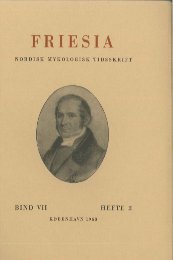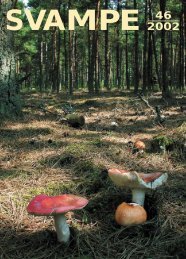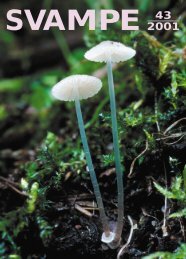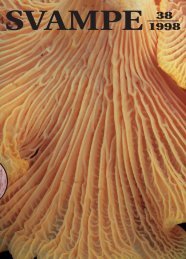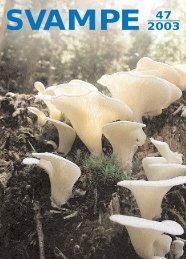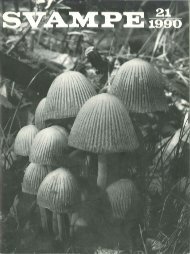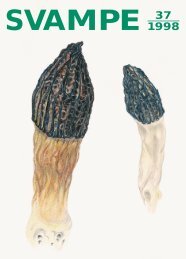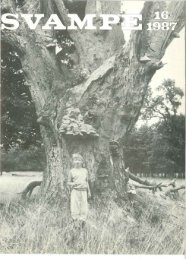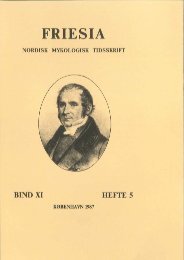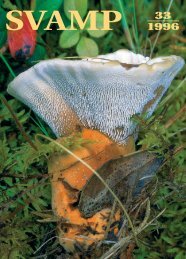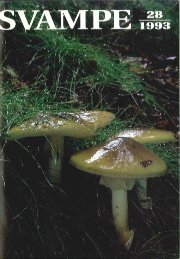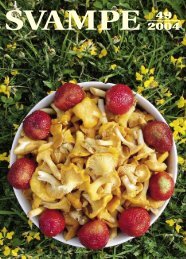You also want an ePaper? Increase the reach of your titles
YUMPU automatically turns print PDFs into web optimized ePapers that Google loves.
-75 -<br />
(1888), Urophiala mycophila Vuillemin (1918), Zygosporium mycophilum<br />
(Vuill.) Sacc. (1911) , Urophiala parasitica (Grove) A. L.<br />
Smith (1920) and Pimina my cophila (Vuill.) A. L. Smith (1920).<br />
D e s c r i p t i o n . The falces (M a s o n has suggested t he term<br />
of falx for a conidiophore of Zygospor i um ) are borne laterally and<br />
singly on the hyphae. They are ere ct, consisting of 4 cells, her e<br />
mentioned after position in distal succession: 1 ) a hyaline, cylindrical<br />
, basa l cell, ab . 2-3 I-' in length, 3 I-' in breadth; 2) a smoked<br />
cylindrica l cell 7.5- 13.51-' (11.21-' )1) in len gt h, ab. 3ft in bread t h ;<br />
3) a dar ker smoked prophialide, dorsiventral, 12.8- 15.81-' (14.51-')<br />
in len gth, 6-7.5 1-' (7 .11-') in breadth. The dor sal pr ofile of t he pro <br />
phialide is sligthly s-formed, its ventral side is equip ped wit h 3<br />
short st umpy beakst ; the en d of whi ch is about 1.51-' in br e.adth.<br />
They are loc ated on the same t r ansve rse axi s, which is situated<br />
ab. 3I-' from the apical wall of t he cell o The two out er beaks are<br />
located symmetrically to the middle one, at angles of ab. 45-60°.<br />
The phialides are borne on t he beaks, and t hey are hyaline, obpyriform,<br />
curving upwards, 4.5-5.31-' (4.71-') in length, 3-3.8ft (304ft)<br />
in breadth. The conidia are hyaline, ellipsoid, 7.5-8.3 X 4.5-5.31-'<br />
(7 .8 X 4.81-') . Finally , 4) the 4th cell in the succession is the so <br />
called apical filam ent. This is mid-placed, hyaline to faintly smoked ,<br />
cylindrical, 7.5-121-' (9.21-') in length, 2.3-3ft (204ft) in breadth,<br />
the apical wall of which bursts at the time of maturing of the<br />
conidiophore, leaving a circular aperture with remnants of the<br />
apical wall left like a collar.<br />
As pointed out by V u i Il e m i n (1910) , sometimes a secondary<br />
conidiophore is formed (see Fig. li), the secondary falx consisting<br />
of only the prophialide and the apical filament. They occur rather<br />
infrequently, only 11 of 1000 falces had a secondary falx developed,<br />
i. e. in ab. 1 % of the cases.<br />
Previous records on the morphology of Z. parasiticum seem to<br />
have been based only on two findings : the original collection of<br />
Pintina parasitica Grove, critically studied by M a s o n (l. c.), and<br />
V u i Il e m i n's (l. c.) material of Urophiala mycophila. A comparison<br />
of measurements is made in Table 2. S a c c a r d o (1911)<br />
who found the fungus on Botrytis does not give any measurements<br />
in his description.<br />
1) Measurements in parenthesis are averages of 10 measurings.<br />
2) M a s o n (1. c.) regards all three «st um ps» as one beak. leannot see<br />
the reason fo r this eoneeption.



